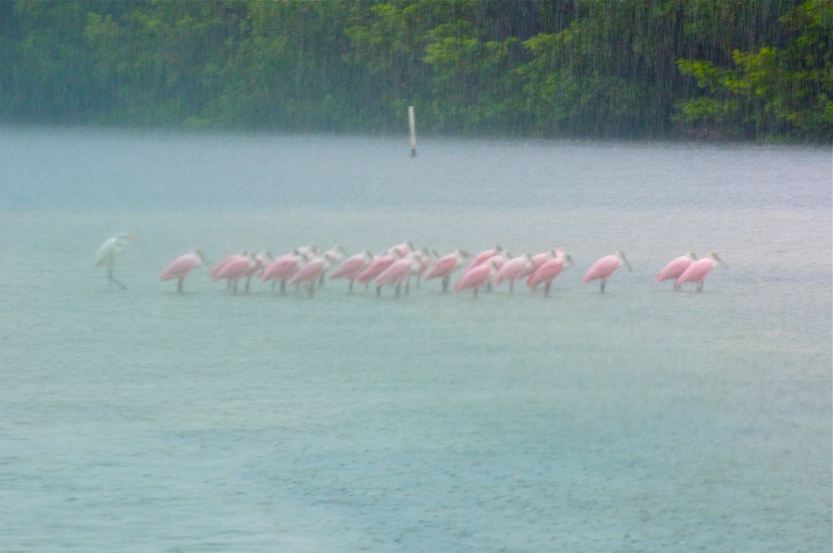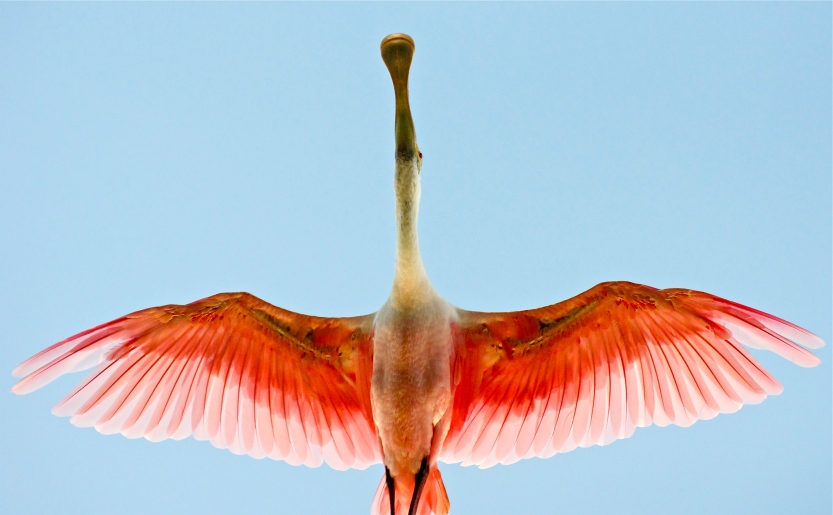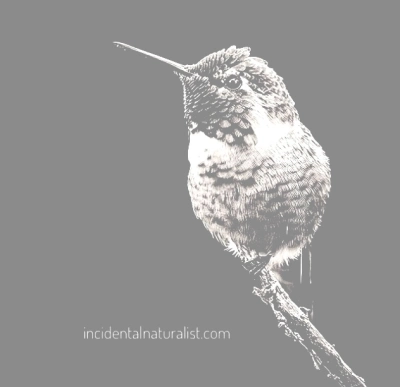The sprawling wetlands of Florida form North America’s premier habitat for egret, heron and ibis. Large bodies of shallow and often tidal water provide ideal feeding grounds for these long-legged birds. There is one member of the American wading bird community that stands out from the crowd – the Roseate Spoonbill.
The Roseate is a special addition to any bird watchers check-list, and accordingly attracts many visitors to Florida each year. Birders come to see and photograph the spoonbills as they feed, in large flocks, on lagoon mudflats. Standing at around 38 inches (96.5 cm) tall, with a wingspan of up to 52 inches (133 cm), this striking bird, with a colour range that runs from pale pink to rich magenta, is often confused with the flamingo. The sensitive, spoon shaped bill that give the family its name is used as a tool for sensing and capturing prey as it sweeps from side to side in shallow cloudy water.
Members of the ibis family, there are 6 species of spoonbill, globally. I have been fortunate enough to have seen three of these, including the two Australian species; the Royal and the Yellow-billed. The Roseate is the only American species, and the only member of the family that is not predominantly white. In common with the flamingo, the pink colouration is a result of pigments present in the aquatic crustaceans that the bird feeds on. As a general rule, the darker the pink colouration, the older the bird.
The Roseate in these images were photographed at the J.N. “Ding” Darling Wildlife Refuge on Sanibel Island, where they are year-round residents. I was aware that the spoonbills are resident on Sanibel and made them a priority bird to see during my week-long trip to the island. Two days of drives through the refuge had passed and I still had not seen a spoonbill, so I stopped to ask a park ranger’s advice. She revealed that the birds leave the refuge during the day, meaning early mornings and just before sunset were the best times to visit. On day three, I drove to Ding Darling just before sunset, camera and binoculars ready for action. As I turned the car into Wildlife Drive, the clouds burst open and a deluge of rain fell, while the sky was torn by shards of lightening.
Standing with their backs to the torrential rain, was a beautiful pink huddle of spoonbills.

Any attempt at capturing a distinguishable photograph through the curtain of rain was out of the question, so I passed the time enjoying the warm, crackling air and the hammer of rain on the car roof.

I returned to the wetland the following evening, and each evening while I remained on the island, just before sunset, in the hope of capturing a glimpse, and maybe a photograph of these fascinating birds. Often they were just a little too far away for my 300 mm lens to give the result I wanted. Occasionally a small group ventured a bit closer. I would have given a great deal to have a 400 mm lens in my bag that I could turn to.

In the early 1900’s the trade in plumes for use as ladies hat decoration was booming, feeding a Florida hunting and poaching industry that saw 5 million birds killed every year. The breeding plumage of the egret species were a prime target, but the Roseate spoonbill, with its stunning pink plumes was the most highly sought after. At one stage, an ounce of spoonbill feathers was valued at twice the price of an ounce of gold. This merciless hunting devastated the population, with numbers dropping to just 30 breeding pairs. Extermination in the United States seemed inevitable.

Thanks to a remarkable campaign and conservation efforts in the United States supporting a successful movement against the plume trade that was pioneered in the United Kingdom by the Royal Society for the Protection of Birds (RSPB), the spoonbills have bounced back. It is estimated that there are now 4000 breeding pairs in the USA, 1000 of which, reside on the Florida coast.

As with all wading birds, the modern day threat to the spoonbill is loss of habitat, as estuaries and wetlands are drained to make way for waterside developments. It would be inexcusable to allow our own hunt for beauty, this time ocean views instead of plumed hats, to push these beautiful, peculiar birds back to the brink. It is a uniquely human characteristic to destroy nature’s finest jewels in order to create an artificial beauty, absent of life and soul.
Standing on the road, by the water’s edge watching the spoonbills feed in the setting sun, I turned to see if there were any birds moving on the mudflats behind me. Hurtling towards me, was a low-flying spoonbill, about to pass directly over my head. Within a second, I leaned back, limbo stick style, and hit the camera’s rapid fire button. I think this moment of good fortune gave me the best photograph of the trip, and a unique view of the Roseate spoonbill.

If you enjoyed this post, please follow Incidental Naturalist.
Comments and shares are welcomed.
Categories: USA





Great fly-by shot! Very interesting and informative post. Enjoyed reading!
LikeLiked by 3 people
Thanks for the positive feedback!
LikeLike
Like this post a lot. I am from Taiwan. We can see the black faced spoonbill in Taiwan. When I was undergraduate, their migration habitat was close to my college campus. I am one of big bird watching fan. Thus, when I came to US, I always want to see the Roseate Spoonbill and haven’t had to do that.
LikeLiked by 1 person
Thanks for this great comment and for sharing your experience in Taiwan. I was fortunate to visit Taiwan many times (not for birdwatching) and found it to be a wonderful place, with beautiful scenery and some of the kindest people that I have met.
LikeLike
Fantastic bird!
LikeLiked by 1 person
Thanks for another visual delight and interesting nature lesson, David. I loved the last picture of the fly by especially. When I first saw pics of these spoonbills in the past I was amazed as I’ve only ever seen white ones in Australia. They are certainly a beautiful looking bird.
LikeLiked by 1 person
Hi Jane, thanks again for another encouraging comment. Always appreciated! I was also amazed when I first saw them, having only seen white ones before. I’m not sure we get to see them often enough on TV or books, compared to the flamingo.
LikeLiked by 1 person
I love the way you write David. Reading your blog is good for the soul!
Such an irony to hear that against the odds a recovery of these spectacular birds occurred only to be threatened again by a quest for ‘artificial beauty, absent of life and soul’. I hold hope that the US will right this wrong, because if they can’t then what hope do we have elsewhere
LikeLiked by 1 person
Thanks for this lovely comment, Margi! I believe the colony that I was photographing will be safe in their preserve for the foreseeable future. I hope that whoever wins the next US election is an advocate for habitat protection.
LikeLike
Hi, David! Very nice images …. really amazing….and your writings are just wonderful….. Here in Assam, we can see only the white spoonbill…. Its really great to see that nature’s creature are so beautiful….. thanks to your for sharing this.
LikeLiked by 1 person
Thank you for your kind words, they are very encouraging! The white spoonbills are also beautiful birds. It is great to be able to share with people all over the world in this community.
LikeLike
Reblogged this on tanguiss.
LikeLike
Yes the not famous cousin of the flamingo it seems. Perhaps it needs more PR or a name change.
LikeLike
Nice post there! Really shows a lot of passion. Please check my blog, I just started and could really use some help by bigger bloggers as yourself. https://thebeautyofspace.wordpress.com/ Please like or follow, at least check it! Thanks
LikeLike
I just found your blog and already, I’m a fan. I will chalk the roseate spoonbill up as one more reason for me to visit Sanibel Island. I’m in Wyoming and about as far from spoonbill habitat as you can get, but I love your photos and learning more about wildlife!
LikeLiked by 1 person
Merci pour ton blog, hyper sympas es très bien réaliser 🙂
LikeLiked by 1 person
Merci beaucoup pour vos aimables paroles!
LikeLiked by 1 person
It’s lovely to know that after so much hunting these birds are starting to bounce back. What a shot that last photo is, simply beautiful. You have made me feel like I might come over to Florida to see them- used to see the white version over here in the UK!
LikeLiked by 1 person
The flyby was a superb shot–it pays to be ready.
LikeLiked by 1 person
Thanks! Pay to be lucky, too! 🙂
LikeLike
Hey David,
Great pics and writing. I started following your blog, saw this post and was reminded of what a spectacular animal this is. Three days later I was lucky enough to spot it from my kayak! (this was in a mangrove in Costa Rica)
I also love nature and adventure, and writing about it, in case you want to check my blog: http://www.chicobonanza.wordpress.com
Pura Vida
LikeLiked by 1 person
WOW you are one the best photographers i have ever seen!
LikeLiked by 1 person
Thank you! That is too much praise, but I thank you for it! 🙂
LikeLiked by 1 person
Wow! Those are awesome photos! I love the last one especially!
LikeLiked by 1 person
Thanks for the kind feedback!
LikeLike
Gorgeous shots! I know there are some living near me, but I’ve never managed to even see a roseate spoonbill here in Gainesville.
LikeLiked by 1 person
Thanks! I’m heading to Crystal River area soon. I’ll let you know if I see any living nearby.
LikeLike